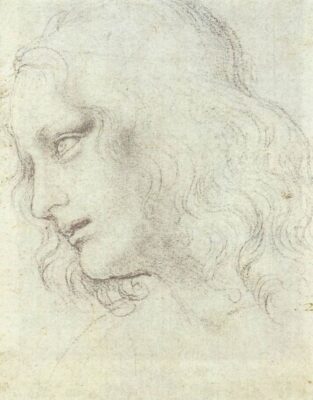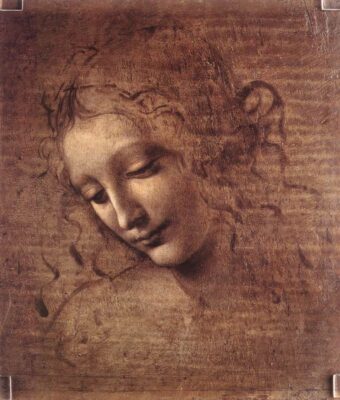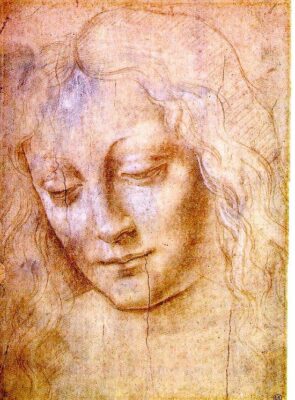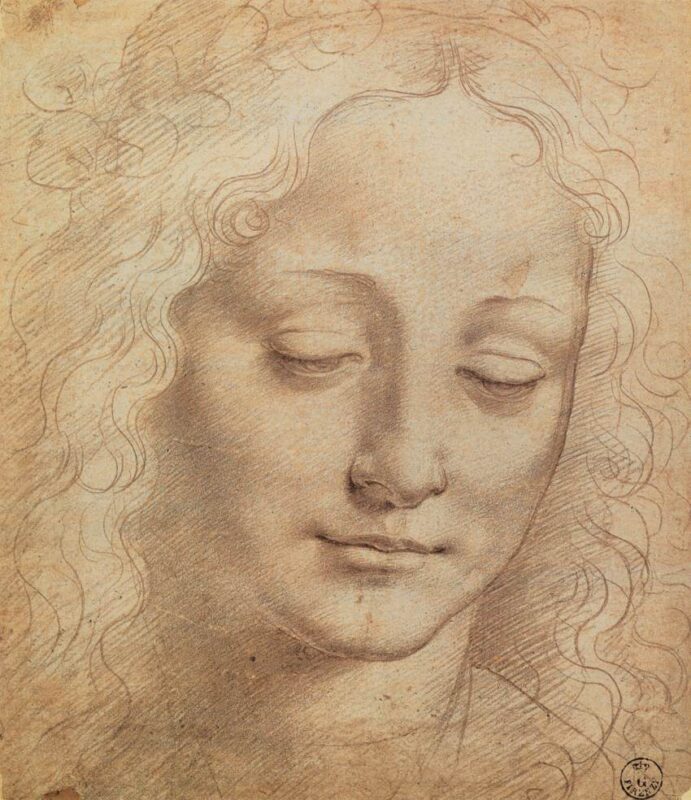Leonardo da Vinci, one of the most brilliant minds of the Renaissance, is renowned for his groundbreaking contributions to both art and science. Among his vast collection of sketches and paintings, Female Head stands out as an exceptional example of his skill in portraiture and his fascination with human anatomy. This unfinished work showcases his deep understanding of the human form and his meticulous attention to detail. Follow archeology.dulichvn.net to learn more about mysterious artifacts.

1. The Creation of Female Head
1.1 Leonardo’s Mastery of Portraiture
Female Head is a prime example of Leonardo da Vinci’s deep engagement with the genre of portraiture, which he refined throughout his career. Unlike many artists of his time, Leonardo went beyond capturing mere physical likeness. He sought to represent not only the outward appearance but also the inner emotional life of his subjects. In this sketch, the subtle expression on the woman’s face conveys a depth of feeling, showcasing Leonardo’s extraordinary ability to breathe life into his subjects.
Even in an unfinished piece, he was able to imbue the figure with an aura of contemplation and mystery, giving viewers a glimpse of the character behind the face. His portraits are famous for their lifelike qualities and psychological depth, making him a pioneer in the evolution of portraiture.
1.2 Leonardo’s Anatomical Precision in the Female Form
More than just a portrait, Female Head is a meticulous study of the female anatomy, highlighting Leonardo’s scientific approach to art. Known for his profound understanding of human anatomy, da Vinci’s observations are evident in the drawing’s precision and detail. The graceful curve of the face, the careful rendering of the jawline, and the natural fall of the hair all reflect his careful study of the human body.
Leonardo’s anatomical expertise allowed him to portray not just the external beauty but the inner structure of the human form. His attention to proportions, musculature, and bone structure provides a deeper understanding of how the body moves and expresses emotion, marking this work as a fusion of art and science.
1.3 Insights from an Unfinished Masterpiece
Though Female Head remains unfinished, its incompleteness offers valuable insight into Leonardo’s creative process. Unlike many artists of the time, who completed their works in a single sitting or stage, Leonardo often left his pieces unfinished, using them as stepping stones in his exploration of artistic ideas.
The fluidity of the lines and the unfinished nature of the details in this drawing reflect Leonardo’s constant refinement of his techniques. This sketch captures his ongoing search for perfection, where each stroke builds upon the last, constantly evolving toward a more complete representation of the subject. The unfinished state of the work does not diminish its brilliance; rather, it enhances our understanding of Leonardo’s pursuit of artistic and anatomical mastery.

2. The Significance of Female Head in Art History
2.1 Leonardo’s Revolutionary Impact on Portrait Art
Female Head holds a special place in the history of portraiture, particularly for its role in revolutionizing how human figures were depicted. Leonardo da Vinci’s dedication to anatomical accuracy and his ability to blend naturalistic details with emotional expression set a new precedent for portrait artists. His approach broke away from the rigid, stylized depictions common in earlier periods, presenting subjects as both physically accurate and emotionally complex.
This fusion of art and science reshaped the Renaissance portrait, influencing not only his contemporaries but also generations of artists who sought to capture the soul of their subjects in a more lifelike and compelling manner. Leonardo’s meticulous study of the human body, paired with his ability to convey psychological depth, laid the groundwork for future artistic developments in portraiture.
2.2 The Deeper Meaning Behind the Female Figure
The female figure in Female Head represents a significant motif within Leonardo’s broader body of work. During the Renaissance, women were often portrayed in art as symbols of beauty, purity, and idealized femininity. However, Leonardo’s approach diverged from the traditional conventions of his time. Rather than adhering to an idealized standard of beauty, he imbued his female subjects with a more realistic, humanized quality.
In Female Head, the woman’s facial expression and form suggest complexity and depth, capturing not just physical beauty but also a sense of individuality and character. This more nuanced representation of women reflects Leonardo’s commitment to portraying his subjects as multifaceted human beings, rather than mere symbols of idealized femininity.
2.3 Connections to Leonardo’s Iconic Works
Female Head shares notable similarities with some of Leonardo da Vinci’s most iconic works, such as the Mona Lisa. Both feature women with soft, ambiguous expressions that have captivated viewers for centuries. The subtle, almost imperceptible smile of the subject in Female Head mirrors the mysterious smile of the Mona Lisa, drawing viewers into a deeper contemplation of the woman’s emotions and psyche. Additionally, Leonardo’s masterful use of sfumato—a technique that softens transitions between light and shadow—can be observed in both works, creating a seamless, ethereal effect.
This technique, along with his careful manipulation of light, helps to emphasize the realism and emotional complexity of the subject, marking a consistent feature of Leonardo’s artistic style. Through these works, Leonardo demonstrates his unparalleled ability to combine technical skill with psychological depth, resulting in portraits that continue to resonate across time.

See more: The Unexpected Find After Pulling Down a False Wall in a 1857 House: Discovering Hidden History
3. The Legacy of Female Head in Modern Times
3.1 A Masterclass in Leonardo’s Artistic Technique
Female Head is not only revered for its aesthetic value but also for the insight it offers into Leonardo da Vinci’s unparalleled technical expertise. The drawing showcases his exceptional understanding of human anatomy, achieved through meticulous observation and study. Art students and professionals continue to examine this work to deepen their understanding of Leonardo’s approach to rendering lifelike figures. His precision in anatomical accuracy, mastery of shading, and ability to create depth and dimension through light and shadow make Female Head a key educational tool for aspiring artists.
The fine detailing, especially in the depiction of the face and hair, highlights Leonardo’s remarkable skill in capturing not only the physical form but also the subtleties of expression, making his work an enduring source of inspiration for contemporary artists.
3.2 The Timeless Allure of Da Vinci’s Work
Leonardo da Vinci’s genius continues to fascinate and inspire art lovers, scholars, and historians across the world. His ability to blend science and art, coupled with his innovative techniques, has ensured that his works, including Female Head, remain among the most admired and studied pieces in the world. The mystery surrounding the subjects he portrayed—often with ambiguous expressions and enigmatic personalities—keeps audiences engaged and eager to explore the deeper meanings behind his art.
The combination of intellectual curiosity and artistic mastery has immortalized da Vinci’s work, keeping it relevant and influential even centuries after its creation. His works, filled with complexity and subtlety, continue to provoke thought and admiration in the modern world.
3.3 Preservation and Accessibility for Modern Audiences
Female Head, along with many of Leonardo’s other works, is part of a broader collection that is carefully preserved and displayed in museums and galleries around the globe. As the interest in da Vinci’s art continues to grow, efforts are underway to digitize and make these masterpieces more accessible to the public. Digital archives, high-quality reproductions, and online exhibitions allow audiences to explore the intricate details of his artwork in ways that were previously impossible.
Through these modern preservation and dissemination efforts, contemporary viewers can gain a closer understanding of Leonardo’s creative process, his technical mastery, and the innovative methods that define his lasting legacy. This digital accessibility ensures that Leonardo’s genius will remain accessible to future generations, continuing to inspire both art enthusiasts and professionals alike.

Conclusion
Leonardo da Vinci’s Female Head is much more than just a portrait. It is a window into the mind of one of history’s most brilliant artists, showcasing his revolutionary approach to capturing the human form. Through his unparalleled skill in blending art and science, da Vinci left a lasting legacy that continues to influence artists and captivate audiences today.


CÁC TIN KHÁC
Mary Walton: The Forgotten Inventor Who Helped Clean Up America’s Cities
Tomb of Queen Nefertari in the Valley of the Queens, Egypt
Discover the Hypostyle Hall of the Temple of Hathor at Dendera
Venus de Losange: Unveiling the Mystery of a 20,000-Year-Old Paleolithic Icon